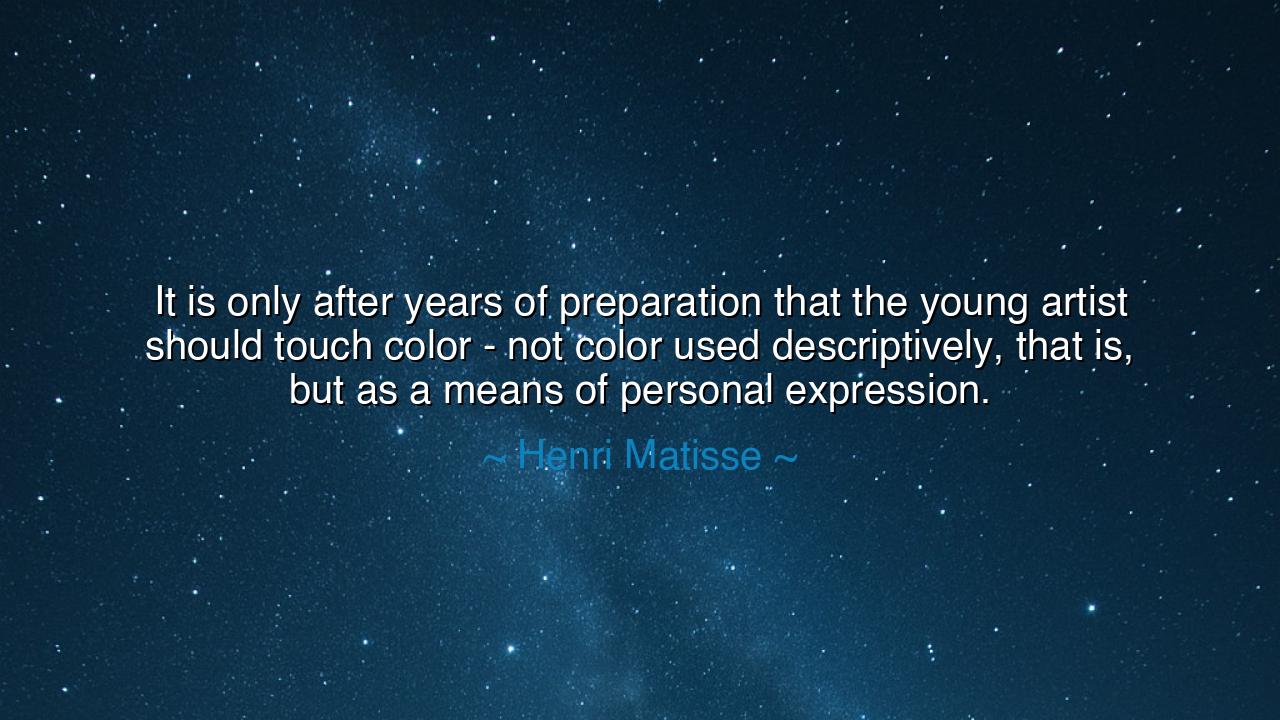
It is only after years of preparation that the young artist
It is only after years of preparation that the young artist should touch color - not color used descriptively, that is, but as a means of personal expression.






"It is only after years of preparation that the young artist should touch color — not color used descriptively, that is, but as a means of personal expression." – Henri Matisse
So spoke Henri Matisse, the great painter of light and emotion, whose art danced between simplicity and revelation. In this statement, Matisse unveils a truth that pierces to the heart of all creation: true expression is not born in haste, but in mastery. When he said, “It is only after years of preparation that the young artist should touch color,” he was not warning against the use of paint, but against the arrogance of unearned expression. He meant that color, the language of the soul, should not be used carelessly to describe what the eye sees — but reverently, to reveal what the heart feels.
The origin of this wisdom lies in Matisse’s own journey. He was not born a painter of brilliance; he was forged through years of discipline and discovery. As a young man, he painted with restraint, studying form, structure, and balance before daring to unleash his palette. It was only through this long apprenticeship to truth and technique that he could later break free from the rules — because he had learned them so deeply that they lived within him. His revolution in color, seen in works like The Joy of Life and Woman with a Hat, did not spring from impulse, but from years of devotion. The freedom of his color was the fruit of mastery, not rebellion.
To Matisse, color was emotion made visible. He saw beyond its descriptive function — beyond using red for apples and blue for sky. For him, color was a tool to express rhythm, harmony, and the hidden vibrations of life. In his paintings, yellow could radiate warmth or joy, green could whisper calm, and crimson could pulse like blood or fire. But such power, he knew, must be wielded with reverence. One cannot speak in color until one has listened to silence; one cannot express without first understanding restraint. Thus, his words remind every artist — and every soul — that expression without depth is noise, but expression with understanding becomes music.
Consider, for example, the story of the Japanese ink masters, who would train for decades drawing only black lines before ever being permitted to use color. Their teachers knew that discipline precedes beauty. Only when the hand no longer trembles and the mind no longer seeks approval can color be used to express spirit. Similarly, Matisse’s own late works — his cut-outs, so seemingly simple — were born from a lifetime of study. To the untrained eye, they looked like child’s play; to those who understood, they were the distilled essence of a life’s wisdom. Every shade was chosen with the precision of the sage and the passion of the poet.
This quote also speaks to a larger truth that transcends art. In every craft — in music, in writing, in leadership, in living — one must first endure the long apprenticeship of the soul. Before a voice can sing with freedom, it must first learn silence. Before a sword can strike with honor, it must first learn restraint. Matisse’s words are a warning to all who mistake inspiration for mastery, who seek to express before they have learned to understand. For expression without preparation is chaos; preparation without expression is death. The balance of both is the path of wisdom.
In his teaching, Matisse reminds us that art is not self-indulgence but self-discovery. The young artist, eager to show the world his passion, must first learn humility — the humility to serve his craft, to listen to form, to study shadow, to master the line before daring to chase the light. When, after years, he finally touches color not to describe, but to express — then his work becomes more than painting. It becomes a reflection of his soul, ripened through struggle, discipline, and grace.
So, remember this, my child of creation: Do not rush to color before you have earned it. Train your eye, your hand, and your spirit. Study the quiet things — proportion, patience, harmony — until they live within you. Then, when the moment comes, when your heart and hand move as one, touch color not to imitate the world, but to reveal your truth. For in that moment, your art will cease to be mere craft; it will become illumination — the pure language of your being, spoken in the tones of eternity.






AAdministratorAdministrator
Welcome, honored guests. Please leave a comment, we will respond soon